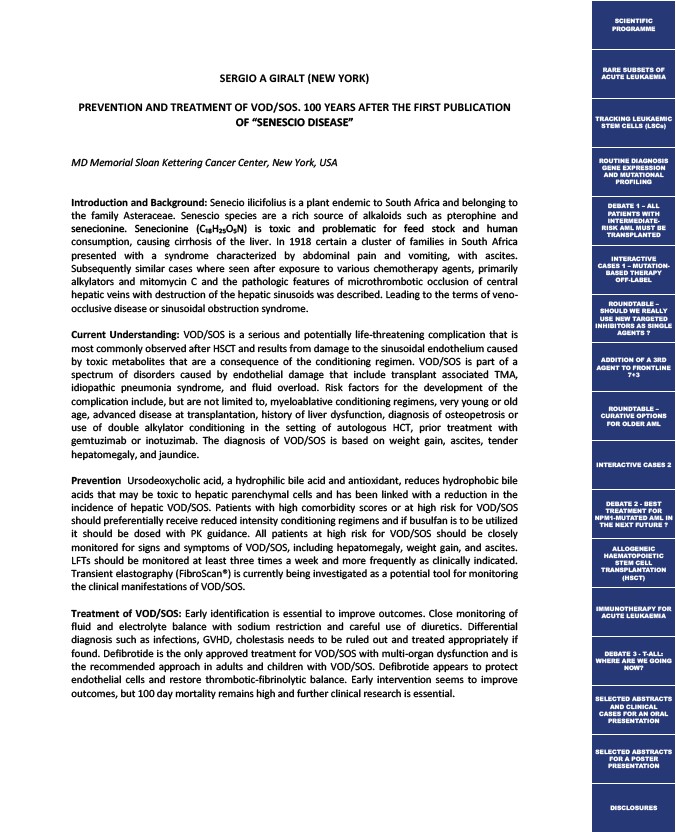
SERGIO A GIRALT (NEW YORK)
PREVENTION AND TREATMENT OF VOD/SOS. 100 YEARS AFTER THE FIRST PUBLICATION
OF “SENESCIO DISEASE”
MD Memorial Sloan Kettering Cancer Center, New York, USA
Introduction and Background: Senecio ilicifolius is a plant endemic to South Africa and belonging to
the family Asteraceae. Senescio species are a rich source of alkaloids such as pterophine and
senecionine. Senecionine (C₁₈H₂₅O₅N) is toxic and problematic for feed stock and human
consumption, causing cirrhosis of the liver. In 1918 certain a cluster of families in South Africa
presented with a syndrome characterized by abdominal pain and vomiting, with ascites.
Subsequently similar cases where seen after exposure to various chemotherapy agents, primarily
alkylators and mitomycin C and the pathologic features of microthrombotic occlusion of central
hepatic veins with destruction of the hepatic sinusoids was described. Leading to the terms of veno-occlusive
disease or sinusoidal obstruction syndrome.
Current Understanding: VOD/SOS is a serious and potentially life-threatening complication that is
most commonly observed after HSCT and results from damage to the sinusoidal endothelium caused
by toxic metabolites that are a consequence of the conditioning regimen. VOD/SOS is part of a
spectrum of disorders caused by endothelial damage that include transplant associated TMA,
idiopathic pneumonia syndrome, and fluid overload. Risk factors for the development of the
complication include, but are not limited to, myeloablative conditioning regimens, very young or old
age, advanced disease at transplantation, history of liver dysfunction, diagnosis of osteopetrosis or
use of double alkylator conditioning in the setting of autologous HCT, prior treatment with
gemtuzimab or inotuzimab. The diagnosis of VOD/SOS is based on weight gain, ascites, tender
hepatomegaly, and jaundice.
Prevention Ursodeoxycholic acid, a hydrophilic bile acid and antioxidant, reduces hydrophobic bile
acids that may be toxic to hepatic parenchymal cells and has been linked with a reduction in the
incidence of hepatic VOD/SOS. Patients with high comorbidity scores or at high risk for VOD/SOS
should preferentially receive reduced intensity conditioning regimens and if busulfan is to be utilized
it should be dosed with PK guidance. All patients at high risk for VOD/SOS should be closely
monitored for signs and symptoms of VOD/SOS, including hepatomegaly, weight gain, and ascites.
LFTs should be monitored at least three times a week and more frequently as clinically indicated.
Transient elastography (FibroScan®) is currently being investigated as a potential tool for monitoring
the clinical manifestations of VOD/SOS.
Treatment of VOD/SOS: Early identification is essential to improve outcomes. Close monitoring of
fluid and electrolyte balance with sodium restriction and careful use of diuretics. Differential
diagnosis such as infections, GVHD, cholestasis needs to be ruled out and treated appropriately if
found. Defibrotide is the only approved treatment for VOD/SOS with multi-organ dysfunction and is
the recommended approach in adults and children with VOD/SOS. Defibrotide appears to protect
endothelial cells and restore thrombotic-fibrinolytic balance. Early intervention seems to improve
outcomes, but 100 day mortality remains high and further clinical research is essential.
SCIENTIFIC
PROGRAMME
RARE SUBSETS OF
ACUTE LEUKAEMIA
TRACKING LEUKAEMIC
STEM CELLS (LSCs)
ROUTINE DIAGNOSIS
GENE EXPRESSION
AND MUTATIONAL
PROFILING
DEBATE 1 – ALL
PATIENTS WITH
INTERMEDIATE-RISK
AML MUST BE
TRANSPLANTED
INTERACTIVE
CASES 1 – MUTATION-BASED
THERAPY
OFF-LABEL
ROUNDTABLE –
SHOULD WE REALLY
USE NEW TARGETED
INHIBITORS AS SINGLE
AGENTS ?
ADDITION OF A 3RD
AGENT TO FRONTLINE
7+3
ROUNDTABLE –
CURATIVE OPTIONS
FOR OLDER AML
INTERACTIVE CASES 2
DEBATE 2 - BEST
TREATMENT FOR
NPM1-MUTATED AML IN
THE NEXT FUTURE ?
ALLOGENEIC
HAEMATOPOIETIC
STEM CELL
TRANSPLANTATION
(HSCT)
IMMUNOTHERAPY FOR
ACUTE LEUKAEMIA
DEBATE 3 - T-ALL:
WHERE ARE WE GOING
NOW?
SELECTED ABSTRACTS
AND CLINICAL
CASES FOR AN ORAL
PRESENTATION
SELECTED ABSTRACTS
FOR A POSTER
PRESENTATION
DISCLOSURES